National defense resourcing is at the center of Congress’ consideration of President Trump’s first defense budget request. Policymakers are tasked with assessing competing claims that America is either underfunding or overfunding its military. However, arriving at a clear assessment is more difficult than merely comparing data points. A clear and complete assessment of defense resourcing begins with understanding the unique nature of America’s defense requirements and the many factors that frustrate direct budget comparisons.
In his final State of the Union address, President Obama claimed that rhetoric “about our enemies getting stronger and America getting weaker” is “political hot air.”[REF] As evidence of this, he asserted that the U.S. “spend(s) more on our military than the next eight nations combined.”
This sort of comparison is routine in political debate, commentary, and even, unfortunately, academic research. The numbers can vary but in general the argument is the same: The U.S. spends many times what other countries, or collections of countries, do, and therefore spends too much. Consequently, the U.S. has more than enough military to meet its needs and should even consider reducing how much it spends on defense.
Flaws in the “Too Much Spending” Argument
However, the “U.S. compared to X” argument ignores a host of factors, which perpetuate a flawed understanding of defense requirements and assessments of U.S. military strength relative to other countries. Uncorrected, these dubious assessments can encourage force structure and funding decisions that are injurious to U.S. national security.
The “U.S. compared to X” argument wrongfully presumes that relative spending translates directly to relative military strength or that the adequacy of U.S. military power should be determined by how much other countries are spending on their militaries. This comparison fails to recognize that differing economic, strategic, and political environments account for large variances between how much a country spends (in U.S. dollars) and what capabilities a dollar can buy in their domestic economies. As such, defense spending is only one part of the equation. Of greater importance is the military power that any level of spending can produce and its relevance to a nation’s security interests.
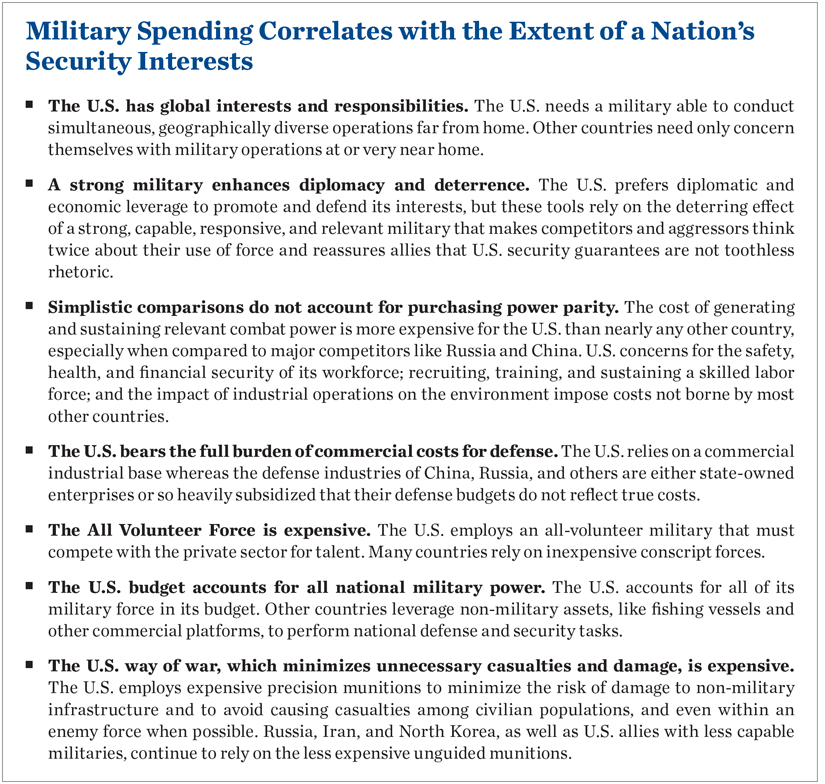
Given the disparities in what it costs to field a force, the extent to which military forces are needed to support the U.S. defense strategy, and the U.S.’s approach to military operations, it is troubling when someone attempts to reduce to a single sentence an important and complex discussion about what it takes to secure America’s interests around the world. America has vital global interests and commitments and thus requires a military force large enough to secure its interests and meet its obligations in multiple regions simultaneously. It also requires a logistics enterprise capable of supplying the range and staying power necessary to project combat power to distant theaters for prolonged engagements. As such, what matters is not what other countries spend, but what it costs to field a force of the size and strength necessary and appropriate to protect American interests.
At present, the U.S. military has a force smaller than at any point since World War II and it is strained to meet the range of obligations assigned to it. Relative to historical U.S. force sizes and the growing capabilities of U.S. adversaries, America’s military is indeed getting weaker—despite President Obama’s claim to the contrary.
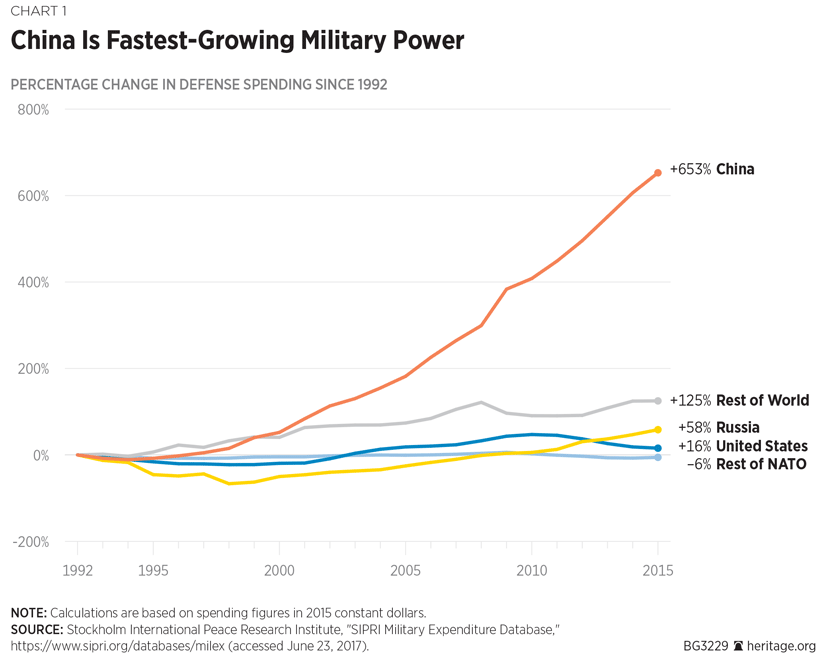
The Nature of U.S. Defense Requirements
After World War II, the U.S. saw that the best way to protect American interests was to remain globally engaged. In order to do so, the U.S. military developed a network of global logistics and power projection capabilities. These capabilities have many associated costs, but—as Madeline Albright and Steven Hadley stated in joint testimony before the Senate Armed Services Committee in March 2017—“history teaches us that whenever problems abroad are allowed to fester and grow, sooner or later, they come home to America.”[REF] Thus, the U.S. maintains a military that can defeat threats at or near their source rather than on its own shores. Such differences make apples-to-apples comparisons of defense spending between nations problematic.
The Need for Power Projection. Regional powers, such as Russia and China, deploy the totality of their military capabilities close to home. Compared to a globally distributed force, physical proximity grants regional powers access to a larger percentage of their force and capabilities at any given time; improves access to established infrastructure and domestic resupply; and results in shorter travel times, enabling regional forces to deploy faster and with less effort.
Local and regional powers tailor their forces to specific theaters, allowing them to take full advantage of the region and its resources, and to build and position a force ideally suited to a confined operating environment. The influence of geography is clearly demonstrated in the force compositions of regional powers.
For example, Russia has invested heavily in ground combat vehicles, artillery, and tanks—reflecting a focus on land warfare—while China has prioritized expansion and modernization of its naval forces, development of anti-ship ballistic missiles, and militarization of islands in the South China Sea—enhancing its ability to defend its maritime territorial claims and inhibit U.S. intervention.
As a global power, the U.S. must be prepared to operate in multiple environments on short notice. This requires a force trained and equipped for a range of scenarios but tailored to none.
In a hypothetical scenario involving Taiwan, the RAND Corporation found “39 People’s Liberation Army (PLA) air bases within 800 km of Taipei (roughly the range of unrefueled fighter aircraft), whereas there is only a single U.S. Air Force base (Kadena AB) within that distance—and only three within 1,500 km.”[REF] A larger number of Chinese bases, in closer proximity to the area of operations, would support a high number and frequency of sorties. Although the U.S. could supplement limited basing and host nation support with rotational forces or bases beyond the unrefueled range of U.S. aircraft, it would require a force approximately three times that of the Chinese force.
Thus, while the U.S. military in the aggregate is still larger than any other military on the planet, its available force is not. For each combat unit, ship, or squadron engaged in military operations on a rotational basis, there are two more sustaining it: one in maintenance and recovery and another in preparation and training. Consequently, supporting a rotational presence requires a force roughly three times larger than the deployed force.
However, not all operational units and systems are ready and available to deploy. In addition to maintaining a continuous presence in the world’s “hotspots,” the U.S. military also conducts stability operations, disaster response missions, freedom of navigation and joint training exercises, and regional deterrence. With U.S. forces divided across multiple areas of operations and among a variety of responsibilities, the percentage of the force ready and available to respond to unforeseen contingencies is much smaller than shallow budget comparisons can convey. Thus, the U.S. requires a larger force than any other nation in order to cover a larger area of operations and a broader mission set. Moreover, power projection requires more than a large combat force; it also depends on a robust network of logistics and support capabilities for force transportation, security, maintenance, and sustainment.
Global Logistics and Support. The key to U.S. power projection capabilities is a robust, globally distributed logistics enterprise. Since the U.S. military routinely operates far from home, and outside the range of domestic resupply, the deployment and sustainment of combat forces abroad depends upon its ability to transport forces, equipment, and other supplies to foreign theaters. Global logistics capabilities enable U.S. combat forces to achieve range and presence unmatched by any other nation in the world.
Although logistics capabilities are critical enablers of U.S. power projection, they do not themselves contribute combat power. As such, it is disingenuous to use the sheer size of each nation’s defense budgets as a proxy for military strength, particularly given the size of the U.S. logistics force relative to those of regional powers.
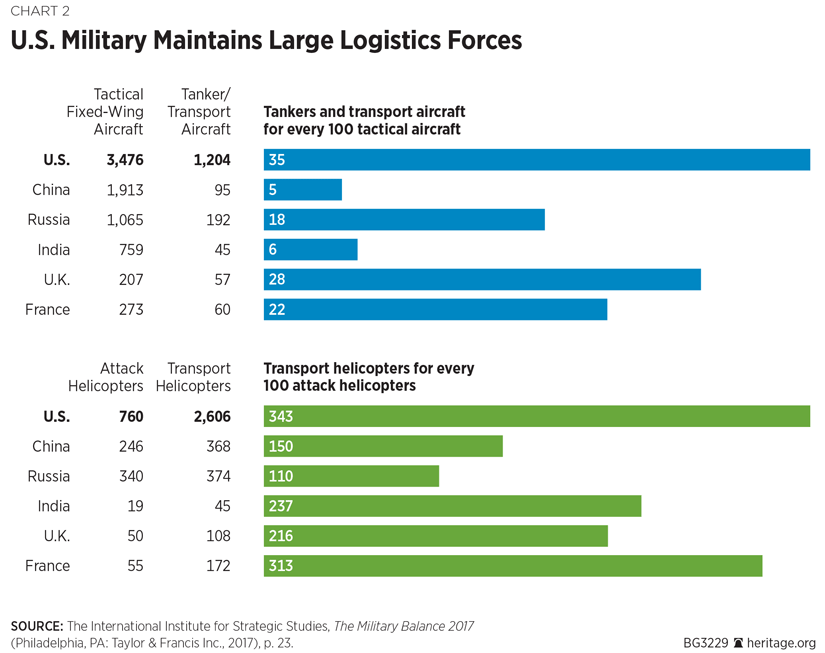
For example, the U.S. fields approximately one tanker or transport aircraft for every three tactical aircraft in the total aircraft fleet,[REF] whereas Russia has one tanker/transport aircraft for every 5.5 tactical aircraft, and China has one tanker/transport aircraft for every 20 tactical aircraft.[REF] Although this may give the U.S. an advantage outside of the unrefueled range of adversary aircraft, distance levels the playing field. A 2015 assessment of U.S. and Chinese military capabilities by the RAND Corporation found that, despite relative U.S. advantages in force size and capability, “in a conflict close to the Chinese mainland, the PLA would enjoy enormous geographic and positional advantages.”[REF] Regional forces enjoy a logistical advantage in local theaters where they can launch strikes from land-based airfields and return to domestic ports and installations to conduct maintenance, refueling, and other necessary supporting requirements. Local logistics and communications infrastructure and facilities “are inherently more robust, more secure, and less expensive than the ship-, air-, or space-based platforms upon which U.S. forces must depend,”[REF] resulting in lower costs and greater convenience for regional powers. Global logistics and power projection are capabilities unique to the U.S., and they carry costs unique to the U.S.
The Value of Deterrence. If an adversary believes the chances of winning an engagement with the U.S. are low or assesses the costs as too high, they may be less likely to pursue a course of conflict. As such, a strong military may not only win wars, but also prevent their occurrence.
Chief of Staff of the Army General Mark Milley stated that the “only thing more expensive than deterrence is actually fighting a war, and the only thing more expensive than fighting a war is fighting one and losing one.”[REF] A large military, despite being expensive to build and maintain, is preferable to the costs of conflict. In addition to the direct costs associated with military operations, wars cost the U.S. in terms of lives, medical and disability payments, equipment reset and retrograde, environmental cleanups, accrued interest on defense appropriations, and in foreign aid and follow-on stability operations.
In order to raise risks to adversaries to unacceptable levels, the U.S. military must be stronger than those of its competitors. Although a stronger force requires higher spending, those investments in defense, in the event that deterrence fails, puts the U.S. in a better position to end wars with less time, effort, and ultimately money spent—as two forces equally matched may enact greater costs and casualties on one another before either is ready to accept defeat. When comparing relative costs and benefits, assessments must factor in the value of deterrence, and the lives and money saved through combat overmatch.
The Value of Extended Deterrence Provided to U.S. Allies. The deterrent value of U.S. strategic and conventional forces also extends to U.S. allies and partners. For example, in accordance with Article 5 of the Washington Treaty, which established the North Atlantic Treaty Organization (NATO), every member of NATO is committed to a principle of collective defense. The treaty states that “an armed attack against one or more of them in Europe or North America shall be considered an attack against them all” and that every member will take any action deemed necessary, “including the use of armed force, to restore and maintain the security of the North Atlantic area.”[REF] Thus, the deterrent force of the U.S. military backs even the smallest NATO members.
In 2016, the U.S. accounted for 45.9 percent of NATO members’ collective gross domestic product (GDP), while accounting for 68.2 percent of total NATO defense expenditures. Although member nations could do more to provide for their own defense, including meeting established benchmarks for defense spending as a 2 percent share of GDP, achieving this goal will not make U.S. military power any less necessary. Many of the U.S.’s NATO allies are small countries with equally small economies. In fact, the U.S. defense budget is already larger than the GDP of 20 out of the 29 member nations,[REF] placing many of the capabilities the U.S. possesses out of reach for most NATO members, even at higher levels of spending.
For example, if Albania (the smallest GDP in NATO) spent 2 percent of its GDP on defense, it could barely scrape together the money for two F-35 fighter jets. Such a purchase would consume Albania’s entire defense budget, and is not a practical use of their money.
However, even countries that meet 2 percent benchmarks and can afford advanced combat platforms may still not be able to afford the costs associated with power projection and distributed logistics. In this way, the unique capabilities provided by the U.S. act as force multipliers. U.S. forces facilitate security cooperation through the provision of transportation, communications, and logistics support for U.S. allies and coalition partners, and enable these forces to operate where they would otherwise be limited by their own resources and capabilities.
For example, while multiple NATO members contributed fighters to allied air campaigns during the Gulf War, “‘the European allies’ lack of capabilities in jamming, refueling, and intelligence, surveillance, and reconnaissance (ISR) meant that the bulk of support missions were carried out by the United States.”[REF]
The Iron Fist Behind the Velvet Glove of U.S. Soft Power. In their testimony before the Senate Armed Services Committee, Albright and Hadley stated:
The international order America built and led has not been perfect, but it has coincided with a period of security and prosperity unmatched in human history. And while many nations benefited from the investments America made in global security and prosperity, none benefited more than the United States.[REF]
Military power provides a silent force behind U.S. diplomatic and economic initiatives, and promotes freedom of navigation and trade—key elements of America’s economic prosperity. While focusing on the costs of a strong defense, critics too often overlook its benefits. As the world’s only globally capable force and given the extent its international obligations, the U.S. rightly spends more on defense relative to the international community. However, even for those who doubt the benefits or necessity of a globally capable force, the comparison still fails from an economic perspective.
How U.S. Defense Spending Compares to That of Other Nations
The differences between the U.S.’s defense requirements and those of other nations make defense budget comparisons largely meaningless. Nevertheless, for those insistent on measuring U.S. spending against dissimilar nations, a number of factors must be considered, including:
- Purchasing power,
- State involvement in industry,
- Personnel costs,
- Structure and quality of military forces, and
- Data transparency.
These factors frustrate a direct comparison such that even if the U.S. fielded a force of the same size and capability as the Chinese or Russian militaries, the U.S. would still spend more on defense than would its competitors.
Purchasing Power Parity. Defense spending comparisons fail to take into account what a dollar (and its equivalent value in other currencies) can buy in the economies of one country to the next. Perhaps the best approximation for a direct dollar-to-dollar comparison is the World Bank’s price-level ratio of purchasing power parity (PPP) to market exchange rate.[REF] The measure is imperfect for this comparison, as it does not take into account the PPP specific to individual goods and services, and does not factor in the impact of defense imports or long-term costs such as future pensions and disability services. However, it does demonstrate the peril of assessing national defense based on budgets alone. For the equivalent investment in terms of U.S. dollars, China and Russia respectively have 1.7 times and 2.5 times the purchasing power within their domestic markets.[REF] After adjusting for PPP, the U.S. only spends more than the next two powers combined: China and Saudi Arabia.[REF] Due to differences in purchasing power across economies, then, two countries could hypothetically field the same size and quality force at dramatically different spending levels.
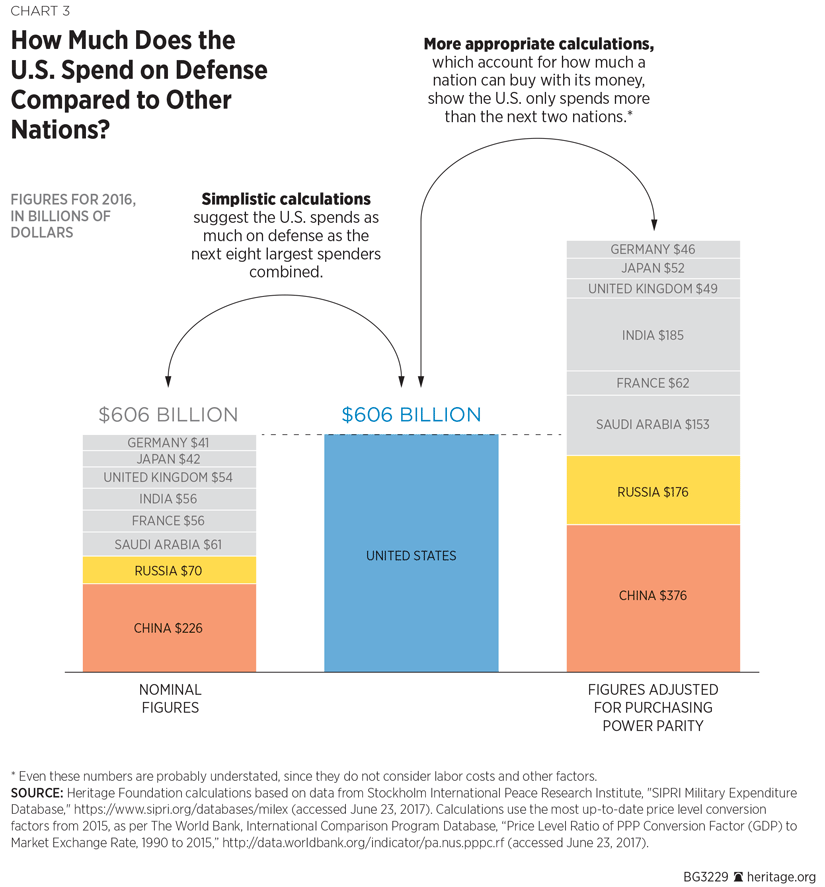
For example, the Chinese Yuzhao-class landing platform dock (LPD) costs approximately $300 million to build and is most similar in terms of displacement and capability[REF] to the U.S. San Antonio-class LPD.[REF] However, the purchase price of the San Antonio-class LPD exceeds $1.6 billion per unit, including research and development (R&D) and procurement costs.[REF] In other words, if the U.S. spent only as much as China, it could buy one-fifth of a San Antonio-class LPD—an absurd proposition following from an equally absurd rationale.
State-Owned Enterprises. Simple cost comparisons also overlook widely differing types of economies and political systems that can significantly influence the costs of defense systems and technologies.
China’s 10 largest defense contractors are all state-owned enterprises (SOEs).[REF] They receive preferential access to federal grants, subsidies, debt forgiveness, land holdings, and raw materials from other SOEs.[REF] State ownership also eliminates many of the costs and challenges associated with intellectual property rights and the need for SOEs to recoup R&D costs and turn a profit on government sales. According to a U.S. Department of Defense (DOD) report on Chinese military power, “China’s two largest state-owned shipbuilders…collaborate in shared ship designs and construction information to increase shipbuilding efficiency.”[REF] Although this system does not encourage competition—a driver of innovation in private markets—China makes up for those shortfalls through robust state-sponsored industrial espionage and intellectual property theft programs.
Although Russia has moved toward the privatization of many former SOEs, its government still holds a large stake in its domestic energy and defense industries.[REF] Such arrangements enable governments to purchase defense systems closer to production costs. DOD procurement costs are much higher, as they account for the full burden of R&D costs that precede private-sector production of defense systems and technologies and supply a profit margin for privately owned companies. Since the DOD is the sole customer of the U.S. defense industry, absent approved foreign military sales, profit margins must be large enough to cover the risks associated with competition for federal contracts. U.S. political indecision and partisan divisions further increase these costs with delayed or partial funding that restrict opportunities for multi-year procurement contracts and large block buys, thus limiting gains from economies of scale and slowing the learning curve for production. Resultant cost discrepancies are compounded for every unit produced. However, the largest portion of the U.S. defense budget is not spent on R&D or procurement, but on rising personnel costs.
Personnel Costs. In fiscal year (FY) 2016, nearly 50 percent of the DOD’s budget went toward military and civilian pay and benefits[REF]—far more than either Russia or China, both in terms of total dollars or as a percentage of defense spending. Comparing defense budgets where a sizable portion of the costs are from personnel introduces a host of issues since the distribution and accumulation of personnel costs varies significantly depending on the economic conditions of a nation, as well as the size, type, or quality of a force.
Cost per Active-duty Servicemember. The U.S. active component uniformed end strength was authorized at 1,301,300 personnel for FY 2016. With a budget of approximately $117 billion for active-duty personnel, the cost is approximately $89,927 per person.[REF]
In 2016, China was estimated to have 2,333,000 active military personnel.[REF] If China spent the same amount per service member as does the U.S., then PLA spending on active personnel alone would amount to $209.8 billion—nearly as much as its total estimated defense budget for 2016 ($215.2 billion) and more than a third of total U.S. defense spending in FY 2016.[REF]
Russian personnel costs, with an active component force of 798,000,[REF] would equate to roughly $71.76 billion, against 2016 total defense expenditures of only $69.2 billion.[REF]
Although costs of living drive a large portion of the disparity in personnel costs, they are also influenced by the type of force fielded by each country.
Conscription Versus All-Volunteer Force. China and Russia both rely largely on military service conscription; they do not depend on financial incentives for personnel recruitment and retention to the same extent as the U.S., which fields an all-volunteer force (AVF). According to the U.S. Air Force, its recruitment and retention goals depend on “Quality of Life programs and initiatives,” that “[keep] military service attractive to potential recruits.”[REF] The DOD offers a wide array of benefits to its personnel, including academic scholarships, health care, housing allowances, and family benefits like child development centers and job assistance for military spouses.
Although Russia is attempting to transition to a professional military, an estimated one-third of its force is still composed of conscripts, and the military is struggling to attract volunteers.[REF] Despite pay increases and limited benefits, the starting salary for Russian contract-service personnel is only “two-thirds that of the national average,” which enables Russia to field a large force at lower cost, but also makes it harder to attract quality personnel.[REF]
Thus, the U.S. AVF, despite being more expensive, is qualitatively superior to a conscripted force because it can attract qualified personnel who freely commit to the service.
Quality of Forces. The U.S. also invests substantial time and resources in educating, training, and equipping its military personnel. These investments result in higher costs per person relative to those of China and Russia,[REF] but produce a highly skilled and effective force. Ensuring that U.S. forces are adequately trained and equipped increases combat effectiveness and decreases risk to service members, enhancing their ability to protect the U.S. and improving their chances of coming home after winning in combat. The technical requirements of advanced systems require a highly trained and well-educated force, which takes time and money to build. As Chinese systems have advanced, they have also become increasingly complex and manned by People’s Liberation Army Navy personnel without the skills necessary to operate them effectively.[REF]
Aside from the wide disparities in the costs of a military described above, analysts must be wary of “official” government figures on defense spending and the types of forces and activities these figures encompass. The validity of nation-to-nation comparisons depends on the assumption that every nation tracks and reports defense spending based on the same metrics and with the same level of detail.
Consistency in Reporting. Since reporting on military expenditures is up to the discretion of individual governments, the level of accuracy and detail can vary substantially from country to country.[REF] DOD estimates of Chinese defense spending consistently exceeds China’s own estimates, in part because its published budget “omits several major categories of expenditure included in the U.S. defense budget such as R&D and the procurement of foreign weapons and equipment.”[REF] The Center for Strategic and International Studies further finds:
Chinese official figures do not account for a number of military-related outlays that are often included in the budgets of other countries. Expenditures may include foreign military procurement, government subsidies for military production, funds for strategic and nuclear forces, and paramilitary organizations. Military-related aspects of Beijing’s space program, extra-budgetary revenues from military-owned commercial enterprises, defense mobilization funds, authorized sales of land or excess food produced by some units, recruitment bonuses for college students, and provincial military base operating costs are absent from China’s officially announced numbers.[REF]
Therefore, spending comparisons based on these figures place equal faith in the reporting of the most and least transparent governments. Although commonly cited data published by the Stockholm International Peace Research Institute (SIPRI) factor in additional costs known to be excluded from some national budgets, baseline estimates must necessarily assume that countries are basically honest, transparent, and thorough in their reported spending—in essence, these estimates are informed guesswork. According to Transparency International, the countries experiencing the fastest growth in defense spending are also among the least transparent.[REF] Among them, China and Russia increased their military spending by 441 percent and 303 percent, respectively, between 2004 and 2014.[REF] Without transparent reporting on military expenditures, the actual increases may be even more dramatic.
Calculating Paramilitary and State-Sponsored Militia Costs. In addition to its conventional forces, China draws from non-defense and even nongovernmental resources to supplement their military forces, particularly in the maritime domain. China pays local fishermen to act as “maritime militias,” and uses its coast guard to bully its neighbors and aggressively assert their territorial claims.[REF] Furthermore, its coast guard cutters share a hull design with its naval frigates—enabling them to be refitted for wartime duty on relatively short notice.[REF] Such practices not only obscure the real size and strength of foreign militaries, but also complicate attempts to compare defense spending. As such, total expenditure shows only a small part of the picture. SIPRI notes in its sources and methods that “[m]ilitary expenditure is an input measure which is not directly related to the ‘output’ of military activities, such as military capability or military security.”[REF] Most assessments critical of U.S. defense spending omit this disclaimer.[REF]
The U.S. Way of War. Furthermore, there are fundamental differences in the way every country protects its interests. The U.S. military has developed the ability to employ precision in warfare, which limits casualties and physical destruction but comes at great monetary cost. Although Russia has some of these same capabilities, it has opted to use “dumb bombs” in Syria. Since precision guided munitions (PGM) are much more expensive than these unguided projectiles, Russia is able to spend less on munitions, but at a greater cost of life. According to a December 2016 report from Human Rights Watch, the Russian-Syrian bombing campaign “often appeared to be recklessly indiscriminate…and included the use of indiscriminate weapons such as cluster munitions and incendiary weapons” in urban areas and around civilian populations.[REF] Meanwhile, the U.S. has nearly depleted its stores of PGMs in its efforts to prevent civilian casualties, and even “unnecessary” deaths of enemy combatants. Although the State Department previously acknowledged that cluster munitions “have demonstrated military utility,” can be cost effective and well purposed in certain environments, and often result in “much less collateral damage than unitary weapons,” the U.S. has committed to dispose of its cluster munitions by 2019.[REF] The U.S. has deprived itself of a critical capability even under the appropriate circumstances, while Russia and China (who also have precision guided technologies) have made no such commitments. This decision increases costs and limits the flexibility and effectiveness of the U.S. arsenal.
The U.S. also commits greater resources for force protection. In recent counterinsurgency campaigns, U.S. military spending included the rapid acquisition individual body armor and Mine Resistant Ambush Protected Vehicles (MRAPs), which provided increased protection for military personnel. While these initiatives contribute to higher costs, they are willingly incurred and reinforce the value the U.S. places on the lives of its service members.
Trends in Global Defense Spending
Some assessments of U.S. defense spending imply that current spending levels are without precedent. However, historical trends and future projections illustrate that this is far from the case and make a strong case for increased U.S. spending.
In 2010, the U.S. spent more than the next 17 countries combined.[REF] However, that defense budget was not the product of exorbitant growth in the U.S. but rather the collapse of the Soviet Union (USSR).
In 1988, the U.S. spent almost the same amount on defense that it does at present—and actually spent more as a percentage of GDP—while the USSR spent approximately 60 percent of U.S. levels.[REF]
Immediately following the Cold War, the world lost its only other major military power and an important frame of reference for any defense spending comparisons.
In 1988, total Soviet defense spending exceeded that of the next 14 countries. As its defense budget dissolved, those 14 countries took its place—resulting in greater U.S. spending relative to global spending and other leading defense spenders. Thus, despite a decrease in U.S. defense expenditures over the same period, U.S. expenditures grew as a percentage of global spending in the years following the collapse.
After a peak in spending in 2010, spending caps imposed by the Budget Control Act of 2011 resulted in a 24 percent decrease in U.S. defense spending through FY 2016. As a result of U.S. budget cuts and growth in defense spending among other major powers, the U.S. now spends only more than the next six countries combined—ignoring all other factors contributing to cost.
Global Trends. Global defense spending rose quickly over the past decade and held relatively constant even after U.S. defense spending began to decline in 2011, following the passage of the Budget Control Act. According to data from SIPRI, global defense spending rose by $262 billion between 2006 and 2016.[REF] Russia and China alone accounted for nearly 64 percent of this increase, while U.S. and NATO spending actually declined. In 2015, Russia and China spent more than the combined total of NATO’s European members.[REF] This has not been the case since before the Cold War. Furthermore, since most NATO members spend a majority of their defense budget on personnel costs, an even smaller portion of this spending is allocated to weapons procurement and modernization.[REF]
Peacetime Spending Versus Wartime Spending. A recent report published by the Watson Institute at Brown University criticized President Trump’s proposed military buildup, claiming that the U.S. is spending more on defense than at any point since President Reagan’s historic peacetime buildup of the 1980s. However, the current security environment is vastly different than it was during Reagan’s terms. Budget requests from the past 16 years reflect the U.S.’s engagement in one conflict or another in the Middle East. Peacetime and wartime spending have different priorities and produce different results. Thus, one must look not only at how much money is spent on defense, but how it is spent.
The growth in U.S. spending through 2010 was a period of consumption, not investment. Most of the budget increase was spent in direct support of major U.S. military operations, while little went to modernizing aging equipment, developing new weapons and technologies, or training for high-end threats from near-peer competitors.[REF] After the peak of these conflicts, federal funding was directed toward recovering from the wear and tear on equipment, deferred maintenance, medical costs, and procurement delays.
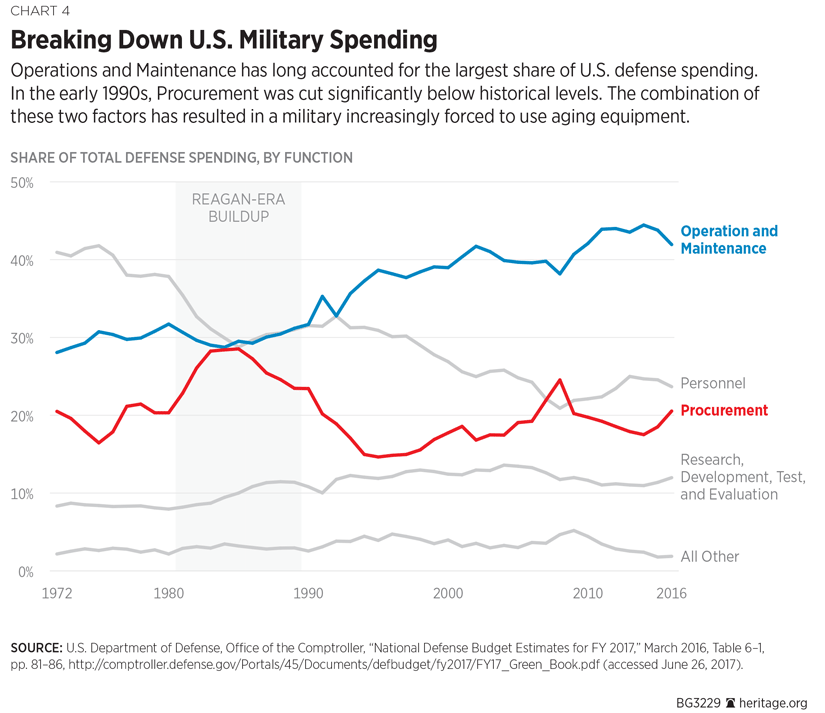
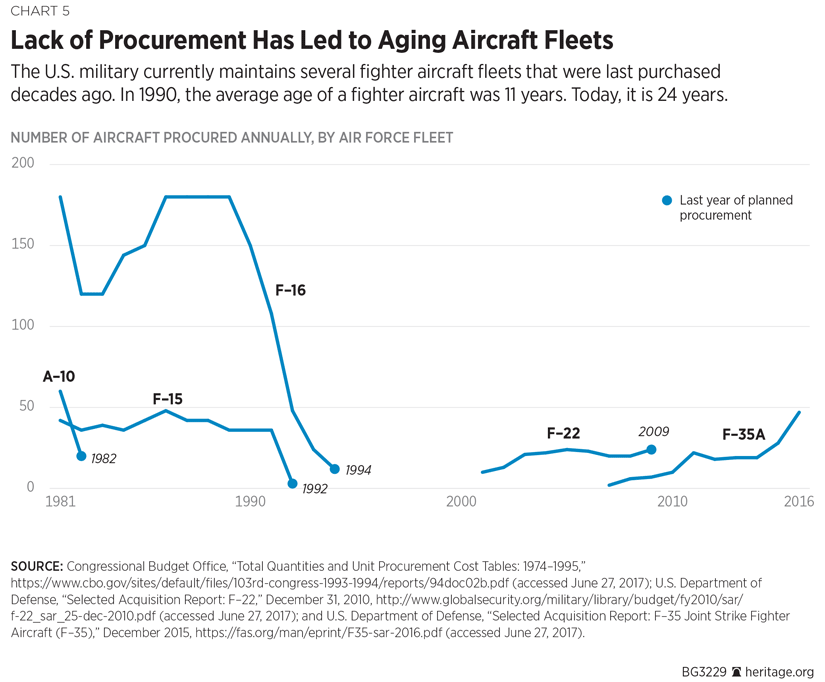
Conversely, over the same period, Russia and China focused on modernizing their forces.
- China initiated the construction of a “blue water” navy, built and militarized islands in the South China Sea, designed and fielded sophisticated anti-access/area denial capabilities, and began construction of a fifth-generation fighter.
- Russia developed a new tank that is considered the most technologically advanced in the world, began an extensive modernization of its nuclear arsenal, and invested in air defense capabilities that rival (if not exceed) those of the U.S.
As such, the outcome of U.S. spending increases in the first decade of the 2000s was drastically different from spending increases during the Reagan Administration, which produced the greatest peacetime modernization of the military in U.S. history.
Conclusion
America’s defense needs are dictated by its interests, alliances, and goals. Head-to-head comparisons with other countries omit the differences in defense requirements from country to country and fail to consider significant differences in costs and economic factors. Rather than asking how much we spend, U.S. lawmakers should be asking what we need to do to provide for the common defense—and endeavor to meet those needs. However, the U.S. should not strive to achieve military defense parity with other countries, in either cost or capability. Rather, the goal of the U.S. should be military superiority, so that when the nation must fight, it will win—and win decisively.
—Rachel Zissimos is Research Associate in, and Thomas W. Spoehr is Director of, the Center for National Defense, of the Kathryn and Shelly Cullom Davis Institute for National Security and Foreign Policy, at The Heritage Foundation. Elad Vaida and Evan Maguire, graduates of the Young Leaders Program, contributed to this Backgrounder.


